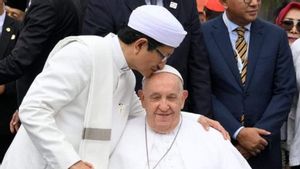JAKARTA – One of the important events in world political history on April 30, 1945 was the death of the German dictator, Adolf Hitler. Der Fuhrer or The Leader was pronounced dead by suicide in his bunker in Berlin, where he was hiding from the pursuit of the Allied Forces.
Hitler was born in Braunau am Inn, Austria on April 20, 1889. His political career emerged after becoming the leader of the National Socialist German Workers' Party (NAZI) in 1921. In 1933 Hitler's power intensified after being elected Chancellor of Germany.

Hitler turned into a dictator after implementing the ideology of the Fuhrerprinzip or Leader Principles on August 2, 1934. This Fuhrerprinzip is understood briefly as "the Leader's word above all written law". That's what causes Hitler's power to be unlimited.
“The Fuhrer unites within himself all the sovereign authorities of the state. All public authority in any state or movement comes only from the Fuhrer or the Leader,” says the Florida Center for Instructional Technology 2005 article Means Used by The NAZI Conspiractors in Gaining Control of the German State.
Nazi collapseAdolf Hitler's actions to invade Poland on September 1, 1939, triggered the outbreak of World War II in Europe. For almost six years he ran rampant with military operations to various countries in Europe, for the dream of realizing Greater Germany.
Signs of Germany's defeat began to appear in 1943. The shadow of that defeat began with the conquest of German troops in the battle at Stalingrad, Russia in February 1943. This defeat eliminated German hopes of conquering Russia.

In June 1944 Allied troops landed in Normandy, France and succeeded in repelling the Germans. In July 1944, several German army commanders surrendered and agreed to cooperate with the Allies to remove Hitler from power.
But the betrayal failed miserably. On the contrary, Hitler raged, furious. He retaliated for the act of betrayal by executing 4000 of his former subordinates who were considered defectors.
Hide in the BunkerBy January 1945, Germany was on the verge of defeat in World War II. It was marked by the siege of Berlin by Russian troops. Hitler, who was cornered and had no room to run, then hid in the bunker.
The bunker is located under the Chancellor's Palace in Berlin, with a depth of 16 meters. From hiding, Hitler continued to inflame the spirit of the German troops to fight the Allies to the last drop of blood.
"No matter how severe the crisis we are in right now, we will be free because of a strong determination that cannot be changed," Hitler said, as told in the BBC documentary The Dark Charisma of Adolf Hitler.

Hitler's hiding bunker is described as having 18 rooms. The bunker is also equipped with independent water and electricity facilities. In the final moments of his reign, Hitler continued to coordinate with his subordinates to determine the fate of Germany. Even Hitler still had time to marry his girlfriend, Eva Braun.
The last decision Hitler made before his death was to appoint Admiral Karl Doenitz as Head of State (President) and Josef Goebbels as Chancellor. Hitler then resigned as Ruler of Germany, and decided to commit suicide with Braun, who had just married a day.
Hitler and Braun's bodies were hastily cremated at the German Chancellery before the Russian troops arrived. Hitler's ashes were then moved to various places to prevent his loyal followers from building monuments in his final resting place.
Eight days after Adolf Hitler died, Germany officially surrendered to the Allies on May 8, 1945. Hitler failed to create Greater Germany, instead the Allies split it into West Germany and East Germany. That is a fragment of an important event in world political history, the death of Hitler on April 30, 1945.
The English, Chinese, Japanese, Arabic, and French versions are automatically generated by the AI. So there may still be inaccuracies in translating, please always see Indonesian as our main language. (system supported by DigitalSiber.id)









